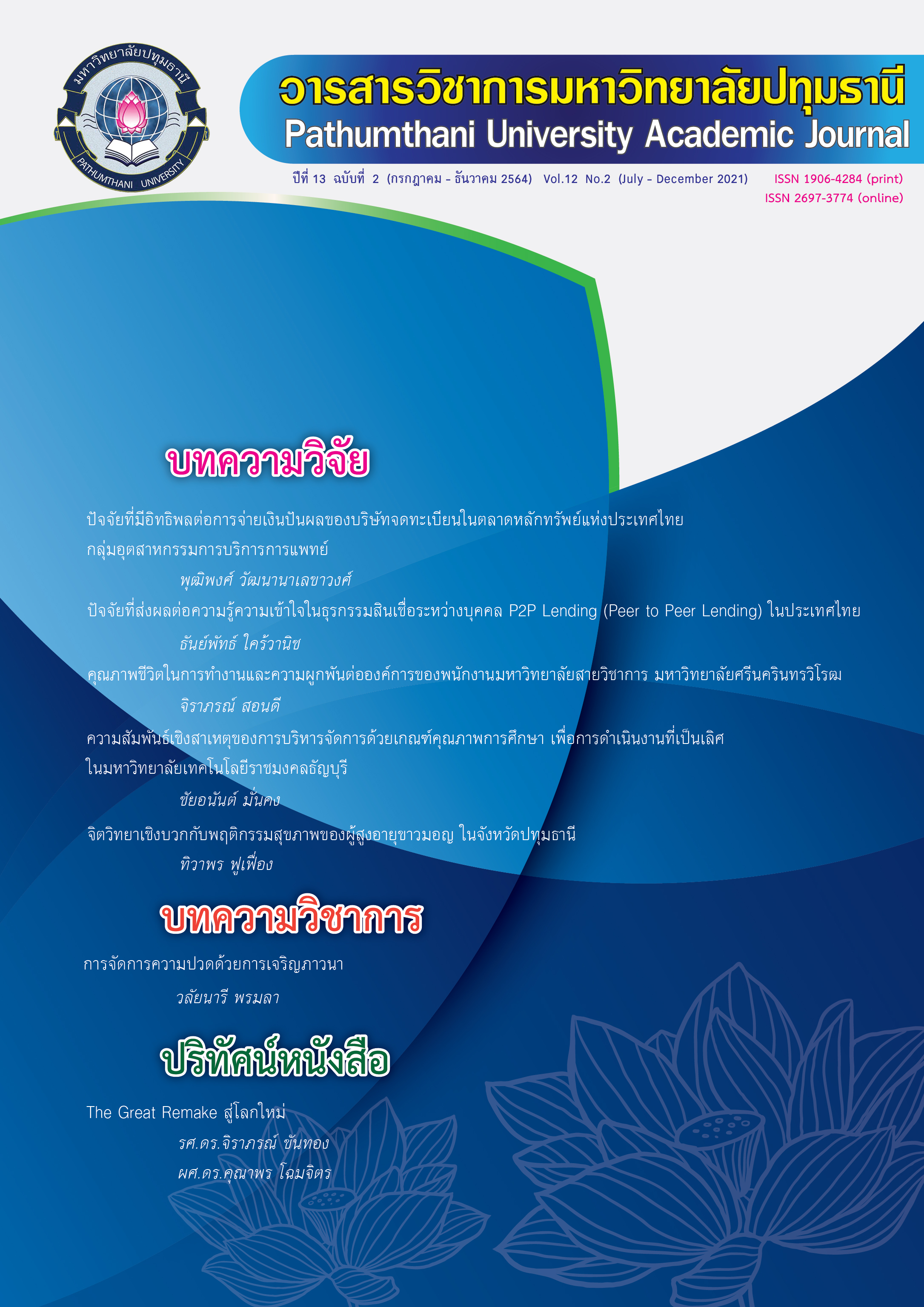FACTORS AFFECTING UNDERSTANDING OF P2P LENDING (PEER TO PEER LENDING) IN THAILAND
Keywords:
P2P lending, Online loan, Financial technologyAbstract
The purpose of this research is to investigate Thai individuals' understanding of peer-to-peer lending and the factors that influence them. Multiple regression analysis was performed to determine the factors influencing Thais' understanding of P2P lending. The findings, based on an online questionnaire of 627 respondents, indicate a significant association between understanding of P2P lending and several factors, including age, the frequency of transactions, and online payment platforms. Age and online payment platforms have a positive impact on the understanding of P2P lending, while the frequency of transactions shows a negative impact. Based on the findings, three recommendations are created. First, the public and private sectors should work together to provide and distribute critical information regarding peer-to-peer lending to the general population, particularly the elderly. Second, in order to promote P2P lending, P2P lending companies may partner with online payment platform providers. Third, in future studies, a more appropriate analysis should be performed to test the hypothesis between numerical variables and categorical variables.
References
Bachmann, A., Becker, A., Buerckner, D., Hilker, M., Kock, F., Lehmann, M., Tiburtius, P., & Funk, B. (2011). “Online peer-to-peer lending – A literature review”. Journal of Internet Banking and Commerce. Vol. 16 No. 2. pp. 2-19.
Banchongduang, S. (2019). Kasikorn-Line offers loan options for unbanked. [Online] Available from https://www.bangkokpost.com/business/1799389/kasikorn-line-offers-loan-options-for-unbanked Cited on 28 August 2021.
Bank of Thailand. (2015). List of peer-to-peer lending platform providers participating in the BOT regulatory sandbox. Available from https://www.bot.or.th/English/PaymentSystems/FinTech/Pages/P2PLendingSandbox.aspx Cited on 28 August 2021.
Bank of Thailand. (2019). P2P lending (Peer-to-Peer lending): New online personal loan services. [Online]. Available from https://www.bot.or.th/Thai/ConsumerInfo/Documents/P2P_3May2019.pdf Cited on 28 August 2021.
Cao, W. (2016). FinTech Acceptance Research in Finland-case Company Plastic. Helsinki, Finland: Aalto University School of Business.
Chitranukroh, A., & Chanpanich, T. (2019). First Peer-to-Peer lending regulation issued by the Bank of Thailand. [Online]. Available from https://www.tilleke.com/wp-content/uploads/2019/06/First-Peer-to-Peer-Lending-Regulation-Issued-by-the-BOT.pdf Cited on 28 August 2021.
Chua-am, M. (2018). “Perceptions and attitudes towards the digital Bitcoin currency in Thailand”. Journal of Business Administration and Social Sciences Ramkhamhaeng University. Vol. 1 No. 3. pp. 83–97.
Chuang, L. M., Liu, C. C., & Kao, H. K. (2016). “The adoption of FinTech service: TAM perspective”. International Journal of Management and Administrative Sciences. Vol. 3 No. 7. pp. 1–15.
Cronbach, L. J. (1971). Essentials of Psychological Testing. (3rd ed.). New York: Harper and Row.
Das, A., & Das, D. (2020). “Perception, adoption, and pattern of usage of FinTech services by bank customers: Evidences from Hojai District of Assam”. Emerging Economy Studies. Vol. 6 No. 1. pp 7-22.
Denwittayanan, K. (2016). Peer-to-Peer lending: Opportunities or risks?. [Online]. Available from https://www.pwc.com/th/en/pwc-thailand-blogs/blog-20160922.html Cited on 28 August 2021.
Ferdiana, A. M. K. & Darma, G. S. (2019). “Understanding fintech through go-pay”. International Journal of Innovative Science and Research Technology. Vol. 4, No. 2. pp. 257–260.
Gao, R. & Feng, J. (2014). "An overview study on P2P lending". International Business and Management. Vol. 8 No. 2. pp. 14-18.
Global Findex. (2017). The unbanked. [Online] Available from https://globalfindex.worldbank.org/sites/globalfindex/files/chapters/2017%20Findex%20full%20report_chapter2.pdf Cited on 28 August 2021.
Johan, S. (2020). “Users’ acceptance of financial technology in an emerging market (An empirical study in Indonesia)”. Jurnal Ekonomi dan Bisnis. Vol. 23 No. 1. pp. 173- 188.
Liu, D., Brass, D.J., Lu, Y., & Chen, D. (2015). “Friendship in online peer-to-peer lending: Pipes, prisms, and relational herding”. MIS Quarterly. Vol. 39 No. 3. pp. 729-742.
Ministry of Finance of Thailand. (2019). The Notification of the Ministry of Finance of Thailand Re: Business Subject to Approval according to Clause 5 of the Revolutionary Council Decree 58 (Personal Loan under Supervision). [Online]. Available from https://www.bot.or.th/Thai/AboutBOT/LawsAndRegulations/Documents/law9_02.pdf Cited on 30 August 2021.
Mendoza-Tello, J. C., Mora, H., Pujol-López, F. A., & Lytras, M. D. (2018). “Social commerce as a driver to enhance trust and intention to use cryptocurrencies for electronic payments”. IEEE Access. Vol. 6. pp. 50737-50751.
Romānova, I., & Kudinska, M. (2016). “Banking and fintech: A challenge or opportunity?”. Contemporary Studies in Economic and Financial Analysis. Vol. 98. pp. 21–35. Available from: https://doi.org/10.1108/S1569-375920160000098002
Schaupp, L. C., & Festa, M. (2018). [Paper presentation]. “Cryptocurrency adoption and the road to regulation”. 19th Annual International Conference on Digital Government Research: Governance in the Data Age. Delft, Netherlands.
Stern, C., Makinen, M., & Qian, Z. (2017). “FinTechs in China – With a special focus on peer to peer lending”. Journal of Chinese Economic and Foreign Trade Studies. Vol. 10 No. 3. pp. 215–228.
Tapkham, P. (2019). The sharing economy: Lessons in borrowing through electronic platforms (peer-to-peer lending). [Online]. Available from https://www.bot.or.th/Thai/MonetaryPolicy/ArticleAndResearch/FAQ/FAQ_148.pdf Cited on 30 August 2021.
Yamane, T. (1967). Statistics, An Introductory Analysis. (2nd ed). New York: Harper and Row.
Yunus, U. (2019). “A comparison peer to peer lending platforms in Singapore and Indonesia”. Journal of Physics: Conference Series. Vol. 1235.
Downloads
Published
How to Cite
Issue
Section
License
บทความที่ได้รับการตีพิมพ์เป็นลิขสิทธิ์ของวารสารมหาวิทยาลัยปทุมธานี
ข้อความที่ปรากฎในบทความแต่ละเรื่อง เป็นความคิดเห็นส่วนตัวของผู้เขียน กองบรรณาธิการไม่จำเป็นต้องเห็นด้วยเสมอไป และไม่มีส่วนรับผิดชอบใด ๆ ถือเป็นความรับผิดชอบของผู้เขียนแต่เพียงผู้เดียว



